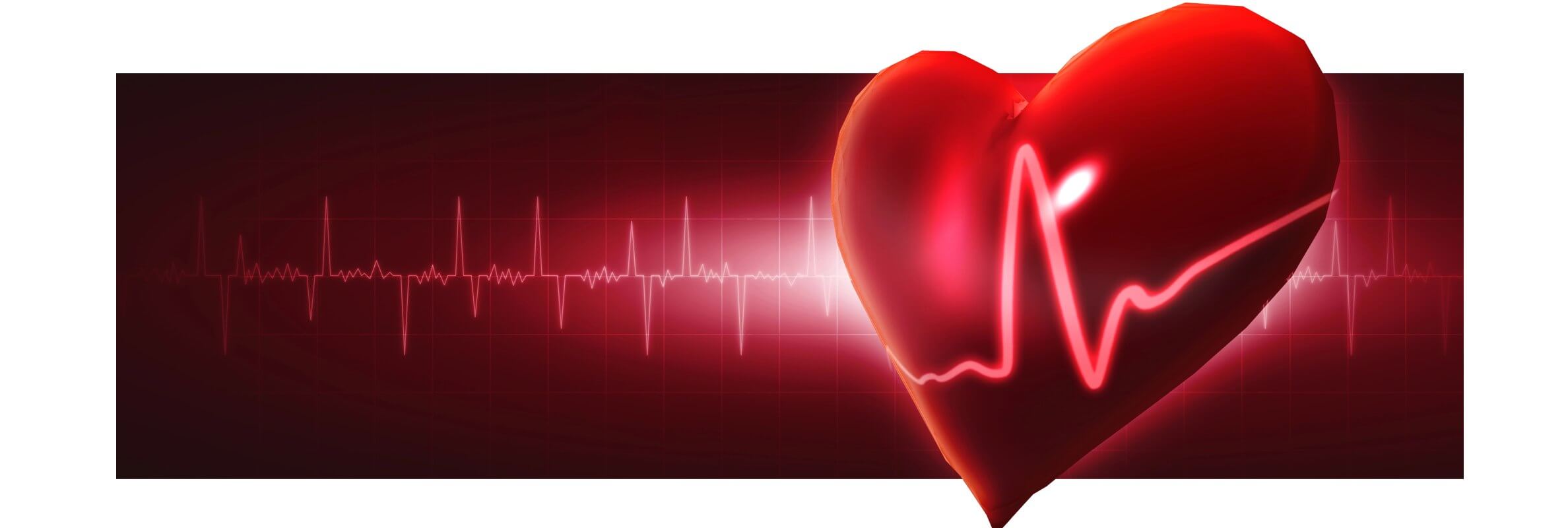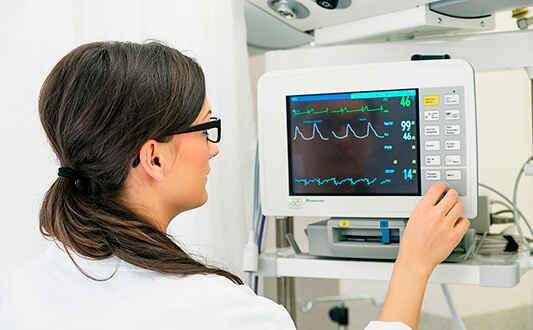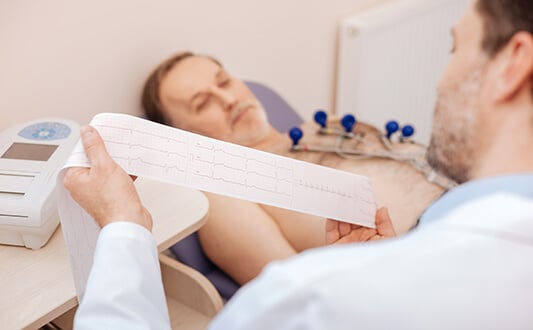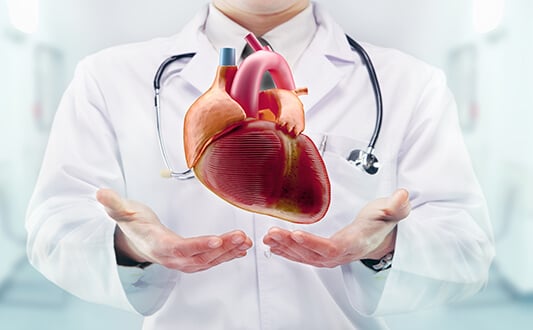Coronary artery bypass grafting (CABG) is a heart surgery aimed at the restoration of the proper blood supply to the heart by creating "new vessels" bypassing the injured ones unable to provide sufficient perfusion of arterial blood.
Thanks to the modern equipment and highly qualified doctors, the leading positions in the coronary artery bypass grafting are held by the following clinics:
- University Hospital Oldenburg, Department of Cardiac Surgery.
- HELIOS Heart Surgery Clinic Karlsruhe, Department of Cardiac Surgery.
- University Hospital Ulm, Department of Cardiothoracic Surgery.
The cost of the medical program depends on the required preliminary examination and treatment tactics. Average prices for coronary artery bypass grafting are listed below:
- Treatment of cardiovascular disease with angina with coronary bypass surgery – 38,040 €
- Cardiac catheterization and coronary artery bypass surgery (CABG) – 38,370 €
- Coronary artery bypass surgery (CABG) with valve replacement – 58,700 €
CABG surgery can eliminate symptoms of coronary heart disease and prevent myocardial infarction. Let's talk about what is CABG in cardiology.
Content
- Indications
- Contraindications
- The course of surgery
- Recovery after heart CABG
- Life after CABG on the heart
- Where is it better to undergo CABG?
Indications
CABG surgery is first of all required for patients with severe cardiac angina, resistant to drug therapy. In addition, surgical treatment can also be recommended in the absence of symptoms. There is painless myocardial ischemia, which is no less dangerous. Patient does not sense any symptoms but it can be diagnosed with ECG and Holter monitoring (recording).
Indications for CABG can be determined by coronary angiography. This is an x-ray study when a contrast substance is injected into the arteries of the heart. The main cause of death from ischemic disease is atherosclerosis and disruption of the integrity of the atherosclerotic plaque. The blood vessel is torn and a blood clot forms at the site of the injury. It clogs the coronary artery, resulting in myocardial infarction.
Coronary angiography can detect large dimensions of obstructions in the path of blood flow (atherosclerotic plaques) and assess the risk of acute cardiovascular events. A high degree of coronary artery disease requires a CABG of the heart.
Following coronary angiography, the main indications for CABG are:
- Narrowing the lumen of any coronary artery by 75% or more
- Reducing the lumen of the left coronary artery by 50% or more
The location of stenosis (impaired patency) of the coronary arteries is also assessed. The more proximal it is (closer to the heart), the worse the blood supply to the myocardium. The most successful is CABG surgery on the heart, if there is a normal circulation of blood beyond the narrowing.
Contraindications
Coronary artery bypass grafting (CABG) sometimes may not be performed in patients, even when the surgical intervention is indicated. This can be caused by the presence of contraindications. These are diseases and conditions of the body that make the surgery too dangerous or inconclusive.
The main contraindications to CABG are:
- Reduction of the left ventricular ejection fraction up to 30%
- Congestive heart failure
- Impaired blood flow in all coronary arteries
- Severe accompanying illnesses
In the case of circulatory disorders in all coronary arteries, laser revascularization of the myocardium or cell therapy is preferred.
The course of surgery
The operation can be performed using an apparatus of artificial blood circulation. Besides, in developed countries, including Germany, CABG on the working heart is increasingly practiced.
The essence of surgical intervention is to create a blood flow. To do this, bypasses are created - additional vessels that exit the aorta and flow into the coronary arteries - beyond the level of constriction. Patient’s own veins or arteries of the person are used as prostheses. It can be a large saphenous vein or a radial artery.
Usually, 3 bypasses are created for the largest coronary arteries:
- Anterior interventricular artery
- Circumflex artery
- Right artery
20% of patients are established 4-8 anastomoses. CABG (coronary artery bypass grafting) on the working heart is given more preference.
The advantages are as follows:
- Blood cells are not damaged
- Rehabilitation after CABG is faster
- The operation has a shorter duration
In this case complications after CABG on the heart are less common. This is due to the fact that there is no risk of those complications that are directly related to the use of the device of artificial circulation. This is the edema of the lungs, embolic lesions of the vessels of the brain or kidneys, hypoxia (oxygen starvation) of internal organs.
Recovery after heart CABG
Immediately after surgery, the patient is on artificial ventilation for a certain time. After the restoration of natural breathing, prevention of stagnant phenomena is required. For this, the patient is offered to inflate the rubber balls several dozen times a day. As a result, the lungs are straightened.
Recovery after CABG on the open heart involves care for the postoperative wound. The incision passes in the middle of the sternum. In addition, there is damage to the lower limbs – place where the doctor took the material for bypass surgery (a large subcutaneous vein). Skin wounds heal within 1-2 weeks. After that, the person is allowed to take a shower.
A bandage after CABG is not an obligatory, but a preferred measure, which reduces the risk of divergence of sternum sutures. While the skin heals on average in 10 days, the bone grows together for several months. Patients often ask how long to wear the bandage after CABG. Usually it is used for 4-6 months.
Arrhythmia after CABG should be absent. If it occurs, it is not a consequence of the operation. A large number of arrhythmia types exists. Some can be caused by myocardial ischemia, others - by independent pathologies, and some - by myocardial infarction. Usually the rhythm of the heart is normalized after surgery by improving the blood supply to the heart muscle.
The consequences of CABG surgery are assessed 2-3 months after it is performed. By this time, angina should no longer disturb the patient. A person is given a stress test and an IVF is taken to understand how much the blood supply to the myocardium has improved. If the pain after CABG is absent with physical activity, the operation is considered successful.
Recovery after CABG can be done in a clinic, in a sanatorium or at home. Naturally, the most successful rehabilitation would be under the guidance of a specialist. But some patients undergo rehabilitation after CABG at home, which is usually associated with a desire to save money. If there is no funds for a qualitative recovery, you need to do it yourself. Exercising after CABG is very important. One needs to walk at least 1 kilometer per day and then gradually increase the distance.
Patients often ask as to when it is possible to sleep on the left side after CABG. Lying on your left side can be almost immediately, if you are comfortable. Most doctors do not forbid this to their patients, since the results of surgery do not affect sleep on the side.
Life after CABG on the heart
A person's life changes only for the better after CABG. Full recovery takes about 6 months. During this time, the sternum grows together and tolerance to physical activity increases. Disability after CABG of the heart is not given. Moreover, disability after CABG can be removed if you again become a working person. If the surgery is successful and there is no concomitant pathology.
Here are a few important questions that patients are often interested in regarding the lifestyle after surgery:
- Shower is allowed 10 days after the surgery (plus or minus 2 days), if the skin wound has healed
- Sauna after CABG of the heart is allowed after 2-3 months, when you pass a control examination (because the temperature drops can trigger a spasm of the coronary arteries and an angina attack)
- Alcohol after CABG is allowed in a moderate amount after the period of early postoperative recovery
- Smoking is prohibited, because it leads to a narrowing of the coronary vessels and increases the risk of their atherosclerotic lesion
- Physical activities after CABG conducted under the guidance of a physical therapy specialist, is required to strengthen the heart muscle and improve tolerance to physical exertion
- Diet after CABG of the heart vessels is desirable, but not mandatory (you can reduce the intake of animal fats to reduce the risk of atherosclerotic plaques in places where they do not yet exist)
A surgical intervention does not guarantee absence of angina or myocardial infarction in the future. CABG only allows you to bypass the narrowed sections of the vessels. But in a few years, new atherosclerotic plaques may appear. Therefore it is important to adhere to a healthy lifestyle and take medication prescribed by a doctor.
Where is it better to undergo CABG?
Coronary artery bypass grafting is done all over the world. Many CIS residents do CABG in Moscow. Often residents of developing countries tend to go abroad for a surgery because it is very complex and requires a long recovery. A better surgery provides better treatment results and a less painful rehabilitation period.
Residents of many countries are sent to have CABG done in USA. Medicine there is really of high quality, but very expensive. It is cheaper to do CABG in Israel. We recommend Germany in our turn. This is the "golden middle": German hospitals are able to provide the same high quality of medical services as in USA, but it is easier to come here for treatment, and the doctors' services are cheaper.
The main advantages of coronary artery bypass grafting in Germany:
- Surgery is performed on a working heart, if possible considering the clinical condition
- The best doctors work in Germany - they come here from all over the world to get medical practice. When performing CABG, the qualification of a cardiac surgeon plays a significant role
- German hospitals are equipped with the latest technology
- After surgery, a person is provided with quality care and medication support, which improves the tolerability of the early postoperative period
- Ability to undergo proper rehabilitation, which will return a person to his previous lifestyle and restore working capacity
Booking Health can organize the treatment for you in Germany. We have been working on the medical tourism market for a long time now, so we can find the best hospital for you. You will be treated by the most respected German specialists.
Thanks to our help, you can save up to 70% of the total cost of treatment and its arrangement. We have negotiated direct agreements with all major hospitals in Germany. For treatment, you do not have to obtain insurance for foreign patients. You will receive the Booking Health insurance, which will cover all unforeseen medical expenses during the treatment period and for 4 years after it.
Choose treatment abroad and you will for sure get the best results!
Authors:
This article was edited by medical experts, board-certified doctors Dr. Nadezhda Ivanisova, and Dr. Bohdan Mykhalniuk. For the treatment of the conditions referred to in the article, you must consult a doctor; the information in the article is not intended for self-medication!
Our editorial policy, which details our commitment to accuracy and transparency, is available here. Click this link to review our policies.
Sources:
National Center for Biotechnology
American College of Cardiology
Read:
Cardiac surgery in Germany – modern treatment of heart disease
Don't know where to start?
Contact Booking Health







